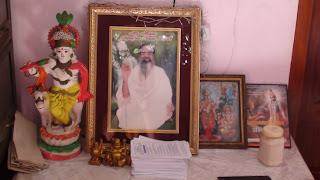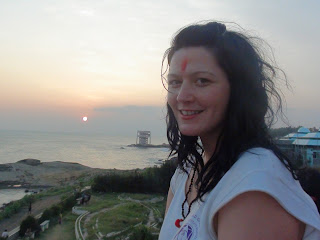Profound Moments in the 'Brighton of South India'
 |
| Breakfast in the station dining hall |
 |
| Swami Isha Layam |
 |
| Pupil of the Isha Layam school |
 |
| Me and Liz with the school children |
In more secular matters, once Swami knew about the professional experiences of Liz and I, he got very excited and called for his colleague to come so that we could spend more time together and explore if we could help them in some of the areas they need support: digital marketing, web development and even music composition and film making (another Indian coincidence - Liz is a composer and I am a wannabe doco maker!) I was perhaps most arrested by the sight of this girl - after beginning her spiritual life in India in none other than the Sivananda ashram that I went to, she began her quest for a guru. She heard about Swami and, she told us that as soon as she met him, she chose to renounce her worldly life to serve and follow him. Meeting this woman was extraordinary. Although we discussed the achievements of Swami and the school and the global energy parliament in a normal fashion with her, she would not be drawn on anything in reference to her own life. She had given it up and renounced it. When Iasked about her family and how they felt at being left behind she simply replied "I try to not have any attachments'. She told us that she felt embarrassed to be before us as she was - she said that her skin was bad, she was ill (she had a terrible cold) and that she was losing weight for no reason. Swami didn't know what the matter with her was. There was no discussion of her going to the doctor. Her conclusion was that her body was obviously going through a stage that it had to go through, in order to continue her journey on the path of servitude to the guru. This didn't make any sense until we saw her with him. We walked over to Swami who was standing in the middle of the school, tenderly speaking with the little children that came his way. Suddenly, the pale devotee was filled with light. It was arresting to watch.
Once we were done with the intensities of Swami and his renunciate, we shored ourselves up with hot street food and fresh coconut juice and hopped on the train for the three hour trip down to Kanyakumari, the most southerly point of this enormous continent. We would also be crossing into Tamil Nadu, the fourth state I had reached in as many weeks. Travelling India by train is a great way to get around - you chug along at pleasant speed and both windows and doors are completely open, allowing you to hang out and witness snapshots of village life. The tropical south is deliciously watery and literally every other minute we passed a lakeside scene: men rearranging their dhotis after bathing, women washing, the proliferation of thousands of lily pads. Everything is picturesque: little children running out of tiny cement houses or standing and gazing out from the mud and the banana leaves, coconut palms swaying in the breeze as sun sets.
 |
| Travelling by train is a pleasant way to go |
 |
| View of the sunset from the train window |
 |
| Sun rise over Kanyakumari |
 |
| Men undertaking Sabarimala |
 |
| The Gandhi memorial 'wedding cake' |
We deposited our 'chappals' ('shoes' - generally not worn inside at all in India and certainly not in holy places), then chose to queue with the other Indians rather than pay for fast track entry to the temple. over Kanyakumari ). We were the only white people - and certainly the only women - in the queue. It seems to be the case with most leisure activities that only the men are present. So we were certainly an object of fascination, which was difficult for us as we were equally as curious to gaze upon our fellow temple goers but did not want to appear provocative. Due to the regulation of the Sabarimala and the fact that the Kanyakumari temple is a place of sacred femininity, men are not allowed to wear shirts. Liz and I found it rather difficult not to stare back too much at the hoardes of hunky half naked men who surrounded us. We found it rather unfair that men are allowed to parade around with their shirts off, meanwhile we, cloistered up in our conservative clothing have to keep our bodies (and our desire) under wraps!
 |
| Crowds gather to watch sun rise |
 |
| Taking the ferry |
In the afternoon we took a rickety old rust bucket of a ferry over to one of the rocks about 500 metres off the tip of Kanyakumari to the Vivekananda memorial, which is where Swami Vivekananda is said to have swam out to, sat upon and meditated before achieving enlightenment. The boat also passed the Thiruvalluvar statue, India's Statue of Liberty, a memorial to the Tamil poet who wrote the Thirukkural, an epic poem on ethics. The statue stands at 133 feet, which denote Tirukkuṛaḷ's 133 Chapters and the show of three fingers denote the sections on Morals, Wealth and Love. Our enjoyment of these philosophical places was somewhat impaired by the excitable group of schoolchildren who were hanging off our arms, asking us what our 'good name' was and asking for photographs. We were like local celebrities!
 |
| Thiruvalluvar statue |
 |
| The school children were loving us! |
In the evening we went back to the highest point of Gandhi's wedding cake and watched the sun set over the three oceans, squeezed once again amongst exicted Indian tourists and as we gazed out over the 3 seas, were filled with an overwhelming sense of profound gratitude for this moment. One extremely hot meal later (we forgot to ask for 'not spicy') and we were back in our very lovely hotel room (we splashed out at 650 rupees and got towels! soap!) ready to begin the next leg of our journey, venturing north up the ancient state of Tamil Nadu.
 |
| Kanyakumari: where 3 oceans meet |
 | ||
| Watching the sun set |
 |
| Gandhi memorial at sun set |


I think children's were enjoyed more. Nice place to visit and for enjoyment.
ReplyDeleteShama Travels
Diwakar Travels Online Bus Booking | Frequent travelers always rely on TicketGoose to book their Bus Ticket to travel using the services of Diwakar Travels. The ease of use of the website attracts hundreds of customers each day toTicketGoose.com if you often visit this page you can get the disount Offers for your ticket.
ReplyDelete